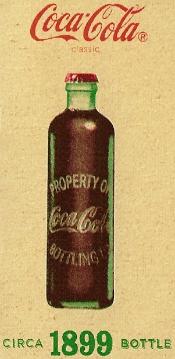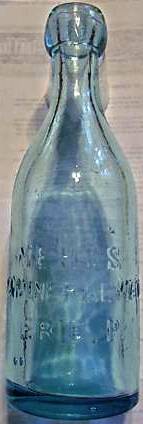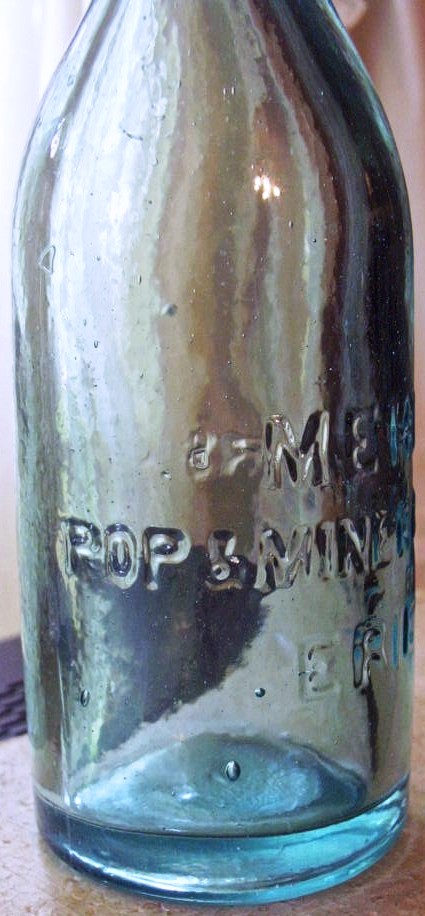Origin of the Term "Soda Pop"
Note: Much of the following information concerning "soda pop" is quoted from Collecting Soda Pop Bottles by Ron Fowler, Seattle History Company, Littlerock, Washington, © 1984 and 2006 (click the book title for additional details and ordering information). Permission is granted to quote HutchBook information only if the source is properly cited, including the HutchBook.com URL.
Unfortunately, the myth that Hutchinson bottles are the source of the term "soda pop" is continually perpetuated by those who reference and cite material from questionable and/or outdated sources. Here are several recent examples:
“The Hutchinson stopper bottle was opened by pushing down on the wire loop. The loud popping sound made by this action is the origin of the term ‘soda pop.’” Coca-Cola Memorabilia, The Collector’s Corner, 2001.
“Charles Hutchinson patented his spring soda-bottle stopper in 1897 (sic)…To open the bottle, one gave the stopper a swift slap with the palm of the hand. When the gasket pushed through, the pressure release created a distinct ‘pop’ sound, and that’s how carbonated drinks became known as soda pop.” Soda Pop! From Miracle Medicine to Pop Culture, Gyvel Young-Witzel & Michael Karl Witzel, 1998.
“The Hutchinson bottle was sealed by a rubber gasket held in place by a long, looping wire. Soda pop got its nickname from the ‘pop’ that resulted when the wire and stopper were pushed down into the bottle.” Secret Formula: How Brilliant Marketing and Relentless Salesmanship Made Coca-Cola the Best-Known Product in the World, Frederick Allen, 1994.
“The industry standard throughout the late 1880s was the Hutchinson stopper, a cumbersome, unpredictable seal with an internal rubber disk pulled up into place by a wire loop. To open the bottle, a consumer knocked the loop down, releasing the pressure with a sudden ‘pop,’ which gave soda pop its name.” For God, Country and Coca-Cola: The Unauthorized History of the Great American Soft Drink and the Company That Makes It, Mark Pendergrast, 1993.
Another often referenced source of such misinformation is The Coca-Cola Company:
A Coca-Cola Company web
site Collectors Column entry authored by Phil Mooney, Director of
Coca-Cola’s Archives Department, states "The
Hutchinson bottles derived their names from the metal stopper device
used to seal them. The stopper contained a seal at the neck. To open
the bottle, the consumer punched down on a metal loop in the stopper,
which broke the seal and made a popping sound. That's what gave ‘soda
pop’ its name.”
Mooney, Director of
Coca-Cola’s Archives Department, states "The
Hutchinson bottles derived their names from the metal stopper device
used to seal them. The stopper contained a seal at the neck. To open
the bottle, the consumer punched down on a metal loop in the stopper,
which broke the seal and made a popping sound. That's what gave ‘soda
pop’ its name.”
A classic (pun intended) example of how misinformation is picked up and spread is the Coca-Cola Company marketing department repeating this myth in conjunction with the campaign promoting their hokey "CIRCA 1899 BOTTLE" in late 2007. Information printed on the cardboard carriers states "The first bottle to be embossed with our trademark, it had a spring-like stopper that made a fun popping sound when it opened. That's where the name 'soda pop' came from."
This is baloney! I have corresponded with Mr. Mooney about the term "soda pop." He cited his “source for associating the soda pop term with the Hutchinson bottle is John J. Riley's book A History of the American Soft Drink Industry published by the American Bottlers of Carbonated Beverages in 1958.” After I shared information from several primary sources, Phil responded “Your research certainly leads us in another direction. I will certainly bear them in mind the next time I address the topic.” While he ponders correction of their published misinformation, people are reading and believing his comments and further spreading this myth, evidence his own company's marketing department! Aaaccckkk!!!
In my opinion, the term "soda pop" originated from the sound made when externally stoppered bottles were opened, i.e. as their corks were released. Some researchers even suggest the term pre-dates the bottling of soda. Consider the following factual sources and decide for yourself:
“Called on A. Harrison and found he was at Carlisle, but that we were expected to supper; excused ourselves on the necessity of eating at the inn; supped there upon trout and roast foul, drank some most admirable cyder, and a new manufactory of a nectar, between soda-water and ginger-beer, and called pop, because 'pop goes the cork' when it is drawn, and pop you would go off too, if you drank too much of it.” Letter penned by English poet laureate Robert Southey in 1812.
“At the beginning of the 19th century soda water consisted of nothing but water, a little soda, and sometimes a bit of flavoring. Soon someone thought to force gas into the water and to keep it there under pressure, the soda water sparkling and foaming when the pressure is removed and the gas escapes. The soda was kept under pressure in cylinders that came to be called ‘soda fountains’…the sparkling, popping soda that came out of the fountains probably was responsible for the name POP for SODA long before soda was bottled." Facts on File Encyclopedia of Word and Phrase Origins, Robert Hendrickson, 1987.
“SODA POP and SODA WATER: American men and women were asking for naturally effervescent ‘soda water’ at ‘soda water fountains,’ and ‘soda shops’ in the 1820s. It was healthy, refreshing, and demonstrated one’s temperance. Such natural soda water was also called ‘seltzer’ from the German ‘Selterser Wasser,’ an effervescent mineral water from Nieder Selters, Prussia. It was joined in 1833 by the new, man-made ‘carbonated water.’ By the mid 1840s people were talking about the new ‘soda counters’ that were being added to many pharmacies…and about local concoctions of carbonated water flavored with syrups and fruit juices which many apothecaries had created as specialties. One of the first two big flavors of the 1840s used the Simlat plant or other ginger flavoring and was called 'sarsaparilla’ (Spanish ‘zarzaparilla,’ ‘zarza,’ bramble + ‘parilla,’ little vine), ‘sarsaparilla soda,’ ‘ginger pop’ (the first use of the word POP), ‘ginger champagne,’ or even ‘ginger ale’…SODA POP and a BOTTLE OF POP were still considered somewhat slangy when used by the flappers and sheiks of the 1920s." I Hear America Talking, Stuart Berg Flexner, 1976.
Frederick Marryat, an Englishman who toured America during the 1830s wrote favorably in A Diary in America (London, 1839) of “the pleasantness, amenity, and variety of the potations.” While in New York for Independence Day in 1837, he was amazed to see the whole length of Broadway lined with booths “loaded with porter, ale, cider, mead, brandy, wine, ginger-beer, pop, soda-water, whisky, rum, punch, gin slings, cocktails, mint juleps, besides many other compounds, to name which nothing but the luxuriance of American English could invent a word." Drink: A Social History of America, Andrew Barr, 1999.
"Flavors were soon added to seltzers, and such mixtures were called 'soda pop' by the 1840s, but the word seltzer has continued to mean an unflavored carbonated water to this day." The Encyclopedia of American Food & Drink, John F. Mariani, 1999.
"IMPERIAL GINGER POP: Take cream tartar one pound; ginger one and a half ounce; white sugar seven pounds; essence lemon one drachm; water six gallons; yeast half a pint. Mix. Tie the corks down." The American Family Keepsake; or People's Practical Cyclopedia. A Truthful Book of Facts and Hints upon Useful Subjects: Expressly Adapted to Meet the Wants of Every Man, Woman and Child in the United States. Good Samaritan, Boston, 1849.
“It is uncertain when soda fountains arrived on the West Coast, but San Francisco had several ice cream saloons in the 1850s. Candy-maker H. L. Winn is credited with opening the first such business in San Francisco, soon after he arrived in 1849. Winn's Fountain Head served ice cream, strawberries, oysters, ginger pop, lemon soda, root beer, and sarsaparilla 'for lovers with their sweethearts and husbands with their better-halves,' according to a newspaper ad." Sundae Best: A History of Soda Fountains, Anne Cooper Funderburg, 2002 quoting Women of the Gold Rush, Elizabeth Margo, 1955.
“By 1859 the number of plants bottling ‘Mineral Waters and Pop’ had been increased to 123.” (Source: 1860 United States Census) Organization in the Soft Drink Industry: A History of the American Bottlers of Carbonated Beverages, John J. Riley, 1946.
"GINGER POP: Water 5 1/2 gals.; ginger root, bruised, 1/4 lb.; tartaric acid 1/2 oz.; white sugar 2 1/2 lbs.; whites of 3 eggs, well beaten; lemon oil 1 tea-spoon; yeast 1 gill. Boil the root for thirty minutes in one gallon of the water, strain off, and put the oil in while hot; mix. Make over night, and in the morning skim and bottle, keeping out sediments." Dr Chase's Recipes, or, Information for Everybody; An Invaluable Collection of About Eight Hundred Practical Recipes. Ann Arbor, Michigan, 1869.
Note the embossed word “POP” in the accompanying photos of a beautiful MEHLS / POP & MINERAL WATERS / ERIE Pa blob top soda bottle. (The photos were graciously provided by GreedyBay seller “drakes1862” -- thanks, Bruce!) According to Brent Allred, noted authority on Erie, PA bottles, Mehls was in business at 61 East 9th Street, Erie, PA, from 1868 until ceasing operations in 1876, three years prior to introduction of Hutchinson’s Patent Spring Stopper. Mehls “POP” bottles utilized cork closures that were either wired down or held in place with Putnam Swing Stoppers.


 HutchBook.com
HutchBook.com